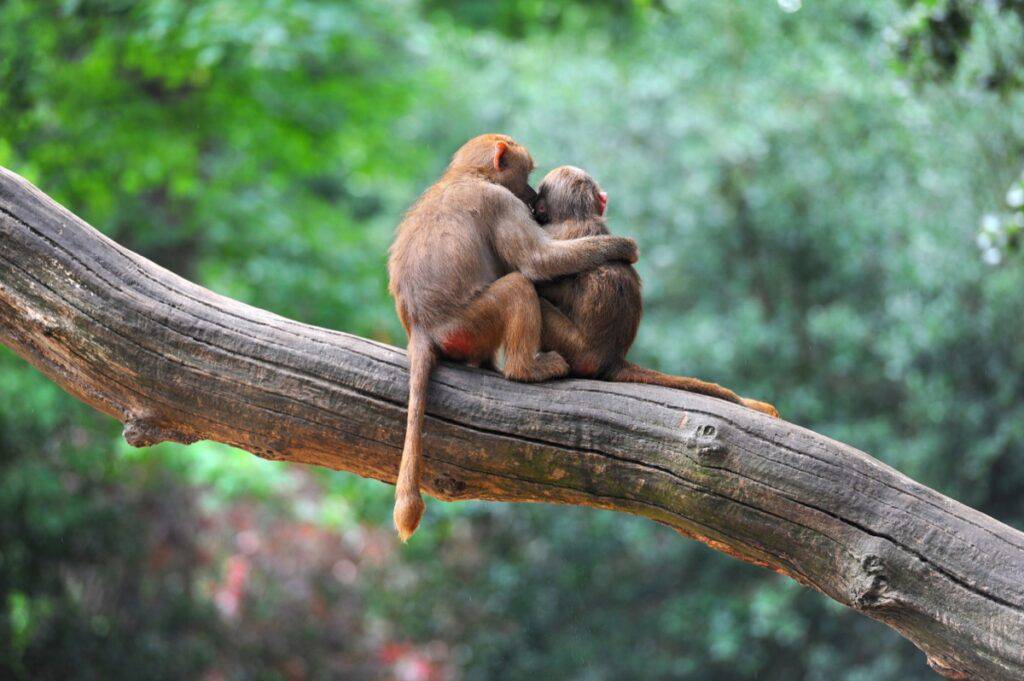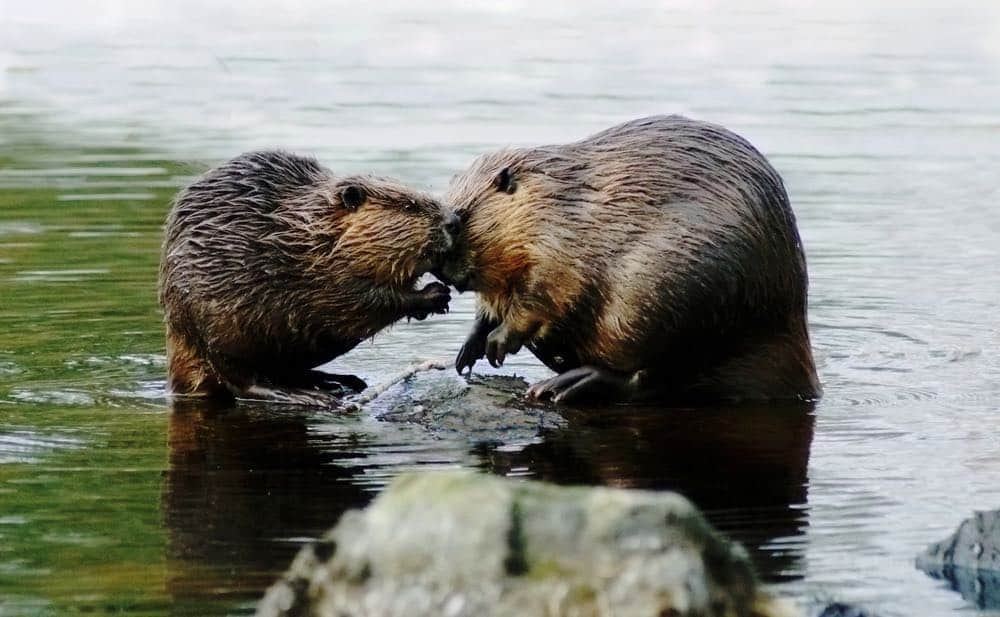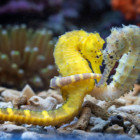Lifelong monogamy in the animal kingdom

As Valentine’s Day approaches, hearts around the world turn to thoughts of love, romance, and enduring connections. While we humans celebrate this day with flowers, chocolates, and heartfelt gestures, the animal kingdom has its own tales of devotion and lifelong partnerships to share.
In the animal kingdom, the concept of lifelong monogamy is both rare and fascinating. While many species engage in mating behaviors, only a select few truly commit to a single partner for life. Join us on a journey through the wilderness as we explore the intricate dynamics of monogamous animal relationships and uncover the creatures that mate for life.
According to the U.S. National Science Foundation, merely three to five percent of the over 4,000 mammal species inhabiting Earth engage in any form of monogamous behavior.
Prior to the emergence of DNA fingerprinting, scientific consensus leaned towards the belief that around 90 percent of bird species practiced genuine monogamy. However, paternity testing has led to a reversal of this perception. It’s now understood that about 90 percent of bird species exhibit social monogamy, while true monogamy among avians is deemed an anomaly rather than the norm.
The Swans: Symbol of Lifelong Monogamy
Our exploration begins with the graceful swans, often revered as symbols of eternal love and devotion. These birds form lifelong pair bonds, often observed gliding gracefully across serene lakes in perfect harmony. Although swans are socially monogamous animals that pair-bond for life, it doesn’t mean they’re faithful partners. See how science disproves what we assumed all along.
Wolves: Loyalty in the Pack
Wolves are highly social animals that form strong family bonds within their packs. While not strictly monogamous, wolves often mate for life within their social group. During courtship, wolves engage in elaborate displays of affection and may even bring food to their potential mate as part of the bonding process. Once paired, wolf couples work together to raise their pups, with both parents contributing to hunting, feeding, and protecting the young.
Gibbons: Duets in the Treetops
Gibbons are highly social primates that form monogamous pair bonds. They often engage in elaborate duets, where both male and female gibbons sing to each other to strengthen their bond and establish their territory. Gibbon pairs are typically seen grooming each other and engaging in physical affection. They share parenting duties and are known to maintain close relationships throughout their lives.
Albatrosses: Soaring Spirits of the Sea
Albatrosses are seabirds known for their impressive flying abilities and long-distance migrations. Many species of albatrosses mate for life, forming strong pair bonds that can last for decades. During courtship, albatrosses engage in intricate dances, bill-circling, and vocalizations. They return to the same nesting site year after year, where they take turns caring for their chick while the other forages at sea.
Sandhill Cranes: Dancing for Love
Sandhill cranes are large migratory birds known for their distinctive calls and elaborate courtship dances. They typically form monogamous pairs that last for life, although if one mate dies, the surviving crane may find a new partner. During courtship, sandhill crane pairs engage in synchronized dancing, leaping, and bowing displays. They build nests in wetland areas, where they raise their chicks together, sharing incubation and chick-rearing duties.
French Angelfish: Swimming Together
French angelfish are colorful reef fish found in tropical waters, known for their striking appearance and monogamous mating behavior. They typically form pairs that defend territories on coral reefs. During courtship, angelfish pairs engage in elaborate displays, swimming together in close proximity and performing intricate dances. Once paired, they work together to maintain their territory, defend against intruders, and care for their eggs until they hatch.
Beavers: Building a Life Together
Beavers are known for their complex social structures and family units. They typically form monogamous pairs and work together to build and maintain their elaborate lodges and dams. During courtship, beavers engage in vocalizations and scent-marking behaviors to attract a mate. Once paired, they share the responsibilities of raising their offspring, including gathering food and maintaining their habitat.

Great Horned Owls
Great Horned Owls are large, nocturnal birds of prey known for their distinctive tufts of feathers resembling “horns” and their hooting calls. They often form monogamous pairs that can last for life, although in some cases, if one mate dies, the surviving owl may seek out a new partner. During courtship, Great Horned Owl pairs engage in vocalizations and aerial displays, with the male often bringing food offerings to the female. They nest in a variety of locations, including trees and cliffs, where they raise their young together, sharing incubation and hunting duties.
Barn Owls
Barn Owls are nocturnal birds of prey known for their heart-shaped facial discs and silent flight. They typically form monogamous pairs that mate for life, although in rare cases, if one mate dies, the surviving owl may find a new partner. During courtship, Barn Owl pairs engage in vocalizations and mutual preening displays. They nest in barns, tree hollows, and other secluded locations, where they raise their chicks together, with both parents participating in hunting and feeding.
Malagasy Giant Jumping Rat
The Malagasy Giant Jumping Rat is a large, nocturnal rodent found in Madagascar. It forms monogamous pairs that remain together for life, sharing territory and raising offspring. During courtship, these rats engage in mutual grooming and scent marking behaviors. They build nests in burrows underground, where they rear their young and forage for food together.
Bald Eagles
Bald eagles are iconic birds of prey known for their majestic appearance and powerful flying abilities. They typically form monogamous pairs that last for life, although in rare cases, if one partner dies, the surviving eagle may find a new mate. During courtship, bald eagles engage in aerial displays, swooping and diving together in synchronized flights. They construct large nests in tall trees or on cliffs, where they raise their young and fiercely defend their territory.
Seahorses: Partners in Parenthood
In the world of seahorses, building trust is not a mere formality but a nuanced dance of shared responsibilities that weaves the fabric of their monogamous relationships. Unlike many other species where parental duties are solely the domain of females, seahorses defy these gender norms. In a remarkable role reversal, it is the male seahorse that takes on the crucial task of carrying and nurturing the developing offspring.
Penguins: Waddling Through Life Together
On the icy shores of Antarctica and the remote islands of the Southern Hemisphere, we encounter the endearing world of penguins, where monogamous bonds are forged amid the harsh conditions of the polar regions. Species such as the emperor penguin and the Adélie penguin form lifelong partnerships, enduring the frigid temperatures and treacherous sea ice together. With synchronized mating rituals and shared incubation duties, penguin pairs navigate the challenges of parenthood with unwavering dedication and teamwork, showcasing the resilience and adaptability of monogamous relationships in extreme environments.
Prairie Voles: The Science of Love
Prairie voles are small rodents found in North America known for their monogamous mating behavior. They form lifelong pair bonds with their mates and often exhibit strong affiliative behaviors towards each other. During courtship, prairie voles engage in mutual grooming, scent marking, and close physical contact. Once paired, they share nesting responsibilities, defend their territory, and care for their offspring together.
Black Vultures: Scavenger Love
Black vultures are scavenging birds of prey found in the Americas, known for their monogamous pair bonds. During courtship, black vulture pairs engage in aerial displays, soaring together in large circles or spirals. They construct nests in caves, hollow trees, or on cliffs, where they raise their young. Both parents participate in caring for the eggs and chicks, regurgitating food to feed their offspring until they are old enough to feed themselves.










